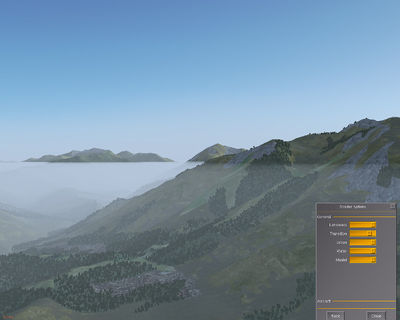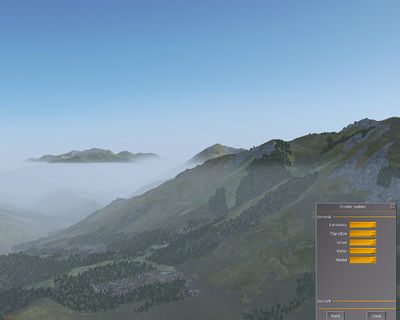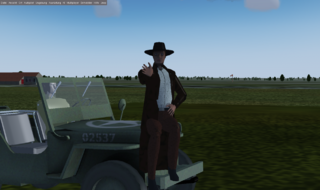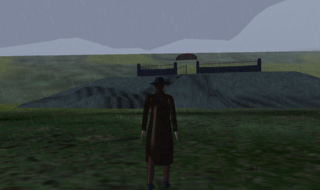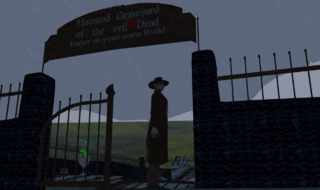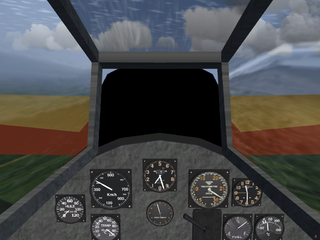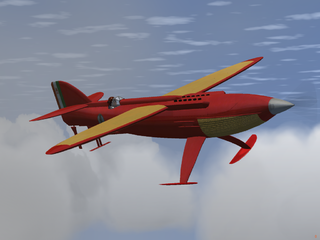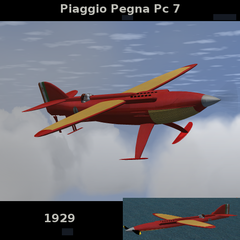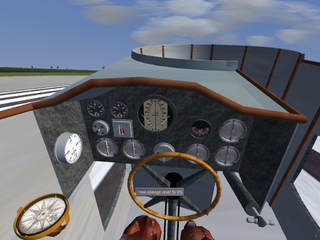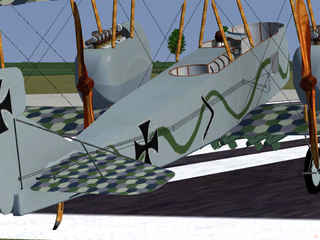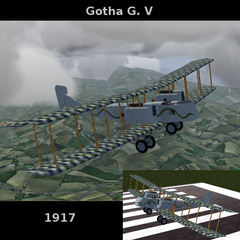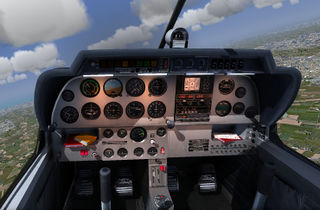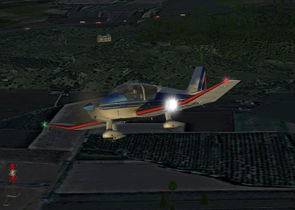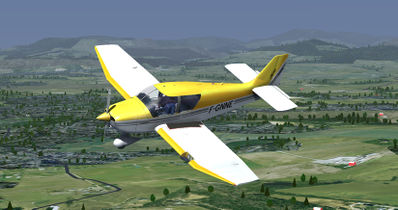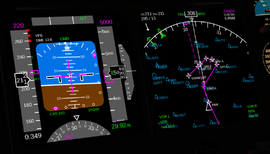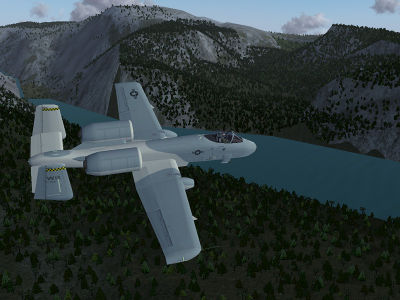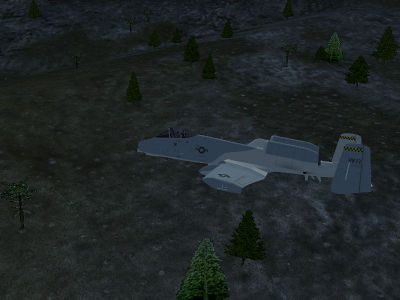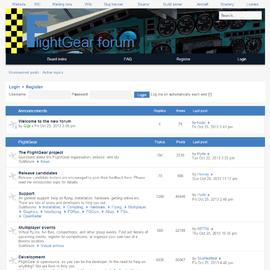FlightGear Newsletter October 2013
|
We would like to emphasize that the monthly newsletter can not live without the contributions of FlightGear users and developers. Everyone with a wiki account (free to register) can edit the newsletter and every contribution is welcome. So if you know about any FlightGear related news or projects such as for example updated scenery or aircraft, please do feel invited to add such news to the newsletter. Core developers are encouraged to add news about their latest work to the newsletter's development section and the changelog of the upcoming release. At the end of each month, it's generally a good idea to get in touch with other contributors to ask them to add news about their contributions to the newsletter.
Note to our Spanish-speaking readers, this newsletter is also available in Spanish, thanks to a translation by provided by FlightGear user Wallkon, see: Es/FlightGear Newsletter October 2013
Development news
Atmospheric Light Scattering
The highest quality shader effect of the Atmospheric Light Scattering rendering framework has received an upgrade in the way the ground fog layer is rendered. Up to now ground haze has been rendered up to a fixed altitude. Close to the upper layer edge, this inevitably leads to an artificially-looking sharp intersection line of fog and terrain. The new effect adds a noise distribution to the line and blurs it selectively, thus leading to a more natural appearance of partially fogged terrain from all altitudes.
FGCom
FlightGear has the voice client FGCom built-in since two months now and all reported bugs has been solved.
The new server is now providing a simple interface showing who is connected at http://fgcom.flightgear.org. You can also find FGCom-sa (standalone) on the download page, or use one of these direct links:
This server is coming with following features:
- Backward compatibilities with old FGCom (wrong frequencies like 127.320MHz instead of the correct 127.325MHz)
- Ready for 8.33KHz frequencies spacing (like channel 118.005)
- ATIS message record
- Web interface monitoring ( fgcom.flightgear.org )
- Use an up-to-date dialplan generated with the latest X-Plane data
People are encouraged to use this server. (FG 2.99+ and FGCom-sa 2.99+ has fgcom.flightgear.org as default server)
FGRun updates
FGRun has been cleaned up of expired options and new options have been added. Some of the more important changes include:
- Checkbox to enable Rembrandt rendering.
- Several rendering options that are no longer in use have been removed.
- FlightGear's built-in anti-aliasing can now be set through Advanced > Rendering.
opentrack
The opentrack project has gained proper, official support for FlightGear!
Please see the readme for head tracking using multiple trackers: face, inertial Rift/Hydra, marker printed on flat paper, freetrack-like light points. You can use it without Nasal scripts, just with protocol definition.
If you have any issues regarding Linux support, compiling, feature requests and usage, please create an issue/feature/support request.
Unfortunately due to being understaffed we presently can't offer binary installers for Ubuntu, Debian and the like. Contributions are extremely welcome!
There's also the forum thread regarding the Linux/Windows software.
Soaring Instrumentation Toolkit
A new project has started for bringing improved support for soaring instrumentation to FlightGear. The soaring instrumentation toolkit is a small library written in Nasal code that allows the creation of glider specific gauges (variometers and glide computers) by connecting elementary blocks together (implemented in OOP). Although still in early stages of development, the library already supports TE (Total Energy) compensated, Netto, Relative (aka Super Netto) and Speed Command variometers. There are plans for supporting final glide computers as well. To learn more about the project, see the forum thread or directly follow the progress in galvedro's fgdata/soaring-sdk branch.
A fun Adventure for Halloween
This is an experiment to explore FlightGear's capabilities beyond simulating flight. You control a human "walker" and explore a cursed graveyard. Find hidden treasures and avoid being caught by evil forces.
Download and instructions at the German website
Getting involved as a programmer
Unfortunately, most of the active FlightGear developers are currently very overstretched in terms of the areas that they have ownership of, which is affecting how much can actually be done. Fundamentally we need more core devs.
If you are interested in contributing as a core developer, please see Howto:Start core development.
In the hangar
New aircraft
Piaggio Pegna Pc 7
Helijah introduces a new old airplane, the Piaggio Pegan Pc 7.Designed to win the "Schneider Cup," the development of the aircraft was too complex and the time available was too short. He never flew :(
Available in this hangar and on Git. Obviously, improvements are welcome as always.
Gotha G. V
Helijah introduces a new old airplane, the Gotha G. V. During the First World War, the Gotha G series devices were among the most effective long range airplanes. They carried the war to England from German airfields located in Belgium.
Available in this hangar and on Git. Obviously, improvements are welcome as always.
Robin DR400 Dauphin
A new Robin DR400 Dauphin is now available. This aircraft is a common general aviation airplane used all over the world.
Features: developed for Rembrandt rendering, tutorials, checklists, tooltips, cockpit details... see the wiki page for more details.
The aircraft is available in Git repository and at PAF team hangar
Updated aircraft
Boeing 747-400 instrument displays
All instrument displays in the Boeing 747-400's cockpit have been converted to the new Canvas system. Instead of complex animated 3D models (with the various layers very close to each other, to feign a 2D instrument), the displays are now relatively simple 2D SVG drawings. The code for the primary flight display (PFD) for example has been reduced by nearly 2000 lines.
Thanks to the flexible nature of a Canvas based instrument, a great deal of new features have been added. Some of these functions include:
- The PFD shows speed limits, reference speeds, ILS guidance, rising runway and autopilot modes.
- The navigation display displays routes, way points and airports. TCAS has been ported as well.
- The primary EICAS has been extended with an expanded gear position indicator (non-normal display in case of gear failure) and pagination for the memo messages.
- The secondary EICAS received two new pages: doors and status.
All displays can be shown in dialogs, so pilots can keep an eye on the display(s) while manipulating switches on the overhead or pedestal. Just click one of the displays to open it in a dialog.
The new displays are already available through Git and will be available for all with the next release in February. A note for aircraft developers: please do not copy them to your aircraft yet. The code that drives the displays will be generalized further, so it can be easily re-used on other aircraft.
Scenery corner
World Scenery 2.0 released
The FlightGear world scenery version 2.0 was officially released during FSWeekend. This new scenery reflects a major improvement over the existing default world scenery and has taken over five years to complete. A much higher level of detail and internal consistency characterizes this new release, in addition to the fact that it will serve as a stepping-stone for further incremental refinements. Although there are currently still a number of known issues with the scenery, the overall flying experience is significantly improved, and the team aims to provide patches for these issues in the near future. The completed build is currently transferred to the terrasync servers and will appear there early November. Once the complete build is uploaded it will also be available for download via http://www.flightgear.org .
This FlightGear World Scenery was compiled from:
- ViewFinderPanoramas elevation model by Jonathan de Ferranti
- VMap0 Ed.5 worldwide land cover
- CORINE land cover 2006v16 for Europe
- Several custom land cover enhancements
- The latest airports (2013.10), maintained by Robin Peel of X-Plane
- Line data by OpenStreetMap
Note that all objects elevation were recomputed. Thus, if some objects were defined with a bad elevation or bad offset, they may have taken a bit of elevation. Use our webforms to fix this.
Regional textures
Enjoy the Norwegian Fjords and the Finnish lakelands in style - regional texture definitions for Scandinavia have arrived on GIT, fully supporting high resolution procedural terrain texturing.
Wiki updates
Philosopher has brought native Nasal syntax highlighting support to the wiki by creating a GeSHi config file for Nasal. We can now use the <syntaxhighight> tag with a lang="nasal" attribute to highlight Nasal code properly. Simply insert code between tags this:
<syntaxhighlight lang="nasal">
# hello.nas
print('Hello World!');
</syntaxhighlight>
And it renders into this:
# hello.nas
print('Hello World!');We will be running a scripted bot to update all our existing uses of "php" markup to use "nasal" instead. To learn more, see Howto:Syntax highlighting for Nasal. Here's a little example showing various highlighted items:
# this is a comment
# operators:
!a ? a+b - c/d*e : f~g;
# Builtin functions, strings
print('Hello World!');
die("We have an error, Houston!", arg[0]);
cmdarg().getNode("setting").getValue();
streq(typeof(id(keys(hash))),10);
# Loopoids
foreach (var a; ["haha", {command:"NASAL!"}, me]) {
if(0) break;
elsif(1) continue;
else return;
while(1) sprintf("%s%s\n%s=%f", "Spam", "spam", "spam", 0e-0);
for (var i=0; i < 0.00; i += 0x0) printf("%d", int(i));
forindex(var o; a) (func {
var o = o;
setlistener("/", func print(o), 1, 2);
})();
}
# String escaping stress tests:
'\a\b\c\"\\\?' # none of these
"\e\?\'\f\a" # none of these
'\'' # this one
"\"\r\n\t\\\t" # and all of these
# And optionally string formatting:
"%s%%s%.0f%8d" # the second "s" shouldn't be highlighted, otherwise everything else
# Syntax error!:
%$@&^|\`Translators required
| The FlightGear Wiki still needs help for translating it into various languages. If you are interested in making the FlightGear Wiki multi-language then start at Help:Translate. | |
| Das FlightGear Wiki benötigt immer noch Hilfe bei der Übersetzung in verschiedene Sprachen. Wenn Du Interesse daran hast, das FlightGear Wiki Mehrsprachig zu machen, dann fang doch mit Help:Übersetzen an. | |
| De FlightGear Wiki kan nog steed hulp gebruiken bij het vertalen van artikelen. Als je interesse hebt om de wiki meertalig te maken, raden we je aan om een kijkje te nemen bij Help:Vertalen. | |
| La FlightGear wiki todavía necesita ayuda para traducirla a varios lenguajes. Si estás interesado en hacer la FlightGear wiki multilingüe, entonces comienza en Help:Traducir. |
Community news
New tutorials and screencasts
Buckaroo's YASim guide updated
Gary "Buckaroo" Neely have released a new version of his Guide To YASim. YASim is one of the two flight dynamic models (FDMs) that comes included with FlightGear, the other one being JSBSim. Depending on the available data either of the models can be used. In general it is said that if aerodynamic test or simulation data is available JSBSim is the better choice and if not YASim is a better choice.
YASim is often used instead of JSBSim as the latter has a steeper learning curve, mostly because of the level of aerodynamics and flight dynamics knowledge that is needed and because enough data rarely is available to make a better than decent FDM. However YASim is not all that well documented and can more often than sometimes be a bit puzzling. Over the years Gary has collected notes on what worked and what didn't as well as have had a look at the YASim code (or so it seems) and have from that made a guide that is available at his hangar (see link above).
If you are new making aircraft with an YASim FDM or want to tweak an existing YASim aircraft to have its performance to better match published data or a flight manual, reading or at least glancing through his guide is highly recommended.
Forum news
On the 25th of October, the FlightGear forum was moved to a new server. At the same time the forum software was updated to the latest version and a new style was installed. The new style is responsive, which means that scales with your screen size. More and more people view the forum on tablets or smart phones, which should be a little easier now. For desktop users, the restyling provides a cleaner, more modern look with more room for actual content. By removing lots of ballast, the forum has also gotten a significant speed up.
From now on, the FlightGear forum lives on http://forum.flightgear.org Please update your favourites to point to the new url. The old links will forward you to the new forum for the time being.
As with all software, some issues will only show up once end-users start using it. Please post to the special forum topic if you've found something that doesn't work, looks broken or is missing.
Useful links
Contributing
One of the regular thoughts expressed on the FlightGear forums is "I'd like to contribute but I don't know how to program, and I don't have the time". Unfortunately, there is a common mis-conception that contributing requires programming and lots of free time. In fact, there are a huge range of ways to contribute to the project without needing to write code or spending days working on something.
For ideas on starting to contribute to FlightGear, you may want to check out: Volunteer.
To learn more about how the project works, please see this short essay written by Thorsten, for a more detailed article see How the FlightGear project works.
Call for volunteers
- The Target4Today team is looking for volunteers to help improving FlightGear's combat support

